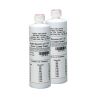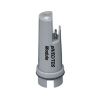Extech ExStik II pH/Conductivity Meter
The Extech ExStik II pH/Conductivity Meter is designed for quick on-the-spot measurements using a rugged flat surface electrode.
Features
- Memory stores up to 25 labeled readings
- RENEW feature alerts user when electrode needs replacement
- 9 units of measure: pH, μS/cm, mS/cm, ppm, ppt, mg/L, g/L, °C, °F
- Expedited repair and warranty service
- Lifetime technical support
- More
The Extech ExStick II pH/Conductivity Meter measures 5 parameters: conductivity, TDS, salinity, pH, and temperature using one electrode. 9 units of measure are available: pH, μS/cm, mS/cm, ppm, ppt, mg/L, g/L, °C, °F. The adjustable conductivity to TDS ratio is from 0.4 to 1.0. Salinity has a 0.5 fixed ratio. The memory stores up to 25 labeled readings, and the analog bargraph indicates sample trends. The RENEW function alers users when the electrode needs replacement.
- Conductivity range: 0 to 199μS/cm, 200 to 1999μS/cm, 2.00 to 19.99mS/cm
- Conductivity maximum resolution: 0.1μS/cm
- Conductivity basic accuracy: ±2%FS
- TDS/salinity range: 0 to 99.9ppm (mg/L), 100-999ppm (mg/L), 1.00 to 9.99ppt
- TDS/salinity maximum resolution: 0.01pH
- TDS/salinity basic accuracy: ±2%FS
- pH range: 0.00 to 14.00pH
- pH maximum resolution: 0.01pH
- pH basic accuracy: ±0.01pH
- Temperature range: 23° to 194°F (-5 to 90°C)
- Temperature maximum resolution: 0.1°F/°C
- Temperature basic accuracy: ±1.8°F/1°C
- Waterproof: IP57
- Memory: 25 datasets
- Dimensions: 1.4 x 7.3 x 1.6" (36 x 186 x 41mm)
- Weight: 3.8oz (110g)
- (1) ExStik meter
- (1) Protective sensor cap
- (1) Sample cup with cap
- (4) 3V CR-2032 batteries
- (1) 48" neckstrap
In The News
Ocean acidification: University of Washington's giant plastic bags help control research conditions
With oceans becoming more acidic worldwide, scientists are getting creative in designing experiments to study them. For example, one group at the University of Washington is using giant plastic bags to study ocean acidification. Each bag holds about 3,000 liters of seawater and sits in a cylinder-like cage for stability. The group at UW, made up of professors and students, is controlling carbon dioxide levels in the bags over a nearly three-week period, during which they are looking at the effects of increased acidity on organisms living near the San Juan Islands. “These mesocosms are a way to do a traditional experiment you might do in a lab or classroom,” said Jim Murray, professor of oceanography at the University of Washington.
Read MoreNOAA Alaska buoy network to monitor North Pacific ocean acidification
National Oceanic and Atmospheric Administration scientists detected signs of ocean acidification in the waters that hold the vulnerable and valuable fisheries of the North Pacific off the coast of Alaska, but they only had a snapshot of the action. “We know that in this place were important commercial and subsistence fisheries that could be at risk from ocean acidification,” said Jeremy Mathis, a NOAA Pacific Marine Environmental Laboratory researcher and professor at the University of Alaska Fairbanks. To understand how ocean acidification affects the North Pacific, NOAA scientists created a mooring network that collects constant in situ data on parameters contributing to acidification. They hope it will reveal seasonal trends and patterns left out by their snapshots.
Read MoreWhat is Conductivity?
UPDATE : Fondriest Environmental is offering their expertise in conductivity through their new online knowledge base. This resource provides an updated and comprehensive look at conductivity and why it is important to water quality. To learn more, check out: Conductivity, Salinity and TDS. Salinity and conductivity measure the water's ability to conduct electricity, which provides a measure of what is dissolved in water. In the SWMP data, a higher conductivity value indicates that there are more chemicals dissolved in the water. Conductivity measures the water's ability to conduct electricity. It is the opposite of resistance. Pure, distilled water is a poor conductor of electricity.
Read More




















